14
Lag using during 'fulling' process at Woollen Mill19th Century, Early 20th Century
Appleton, Town of Mississippi Mills, Ontario, Canada
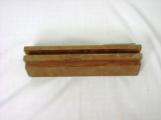 Credits:
Credits:North Lanark Regional Museum (2008.10.1)
Donated by Stewart Neil
15
This lag was used at the Appleton Woolen Mill during the fulling process.FULLING is an additional step in wool processing that helps thicken or even felt the wool. After the strands of wool are woven into a cloth the wool is then beat and immersed in water to help shrink any loose fibres. The beating process agitates the wool fibres causing the microscopic barbs on the wool to attach together creating a stronger fabric or, if the agitation continues, creating felt.
16
Inventory of Dyestuffs at J.A. Teskey's Mississippi Woollen Mills.Circa 1862-1900
Appleton, Town of Mississippi Mills, Ontario, Canada
 Credits:
Credits:North Lanark Regional Museum (2012.55.145.59)
Donated by Sheila Babb and Ann E. Love
17
Letter to A.J. Teskey, ordering flannel8 November 1886
Appleton, Town of Mississippi Mills, Ontario, Canada
 Credits:
Credits:North Lanark Regional Museum (2012.87.21)
18
Letter addressed to Mr. A. J. Teskey of Appleton. This could be addressed to John Adam Teskey, the owner of the Mississippi Woollen Mill, his Uncle Albert Teskey owner of the general store in Appleton, or another Appleton Teskey involved with the family businesses. The letter reads:Franktown November 8th, 1886
Mr. A.J. Teskey
Dear Sir,
Will you please send to my address, (Franktown Station) flannel enough for two outside shirts and two night dresses. You may choose the material and quality of it and oblige.
Hoping that you are well, I will close.
I am yours truly,
J.W. Runions
Franktown
19
Mississippi Woollen Mills (c.1880-1937)Late 1800s Early 1900s
Appleton, Town of Mississippi Mills, Ontario, Canada
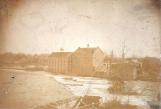 Credits:
Credits:North Lanark Regional Museum (2012.55.145.55)
Donated by Sheila Babb and Ann E. Love
20
Almonte Gazette Clipping: The Mills of Appleton10 March 1899
Appleton, Town of Mississippi Mills, Ontario, Canada
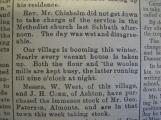 Credits:
Credits:North Lanark Regional Museum, Almonte Gazette
21
Clipping from the "Appleton News" section of the Almonte Gazette March 10, 1899:"Our village is booming this winter. Nearly every vacant house is taken up. Both the flour and the woolen mills are kept busy, the latter running till nine o'clock at night."
22
The mills were a large source of employment in Appleton. Many local residents worked at the mill, while many others boarded in Appleton. The mill employees helped support the various local businesses in Appleton including the general store, the blacksmith, the cobbler, the cheese factory and the two churches among others.23
Almonte Gazette Clipping: Woollen Mill Employees13 January 1899
Appleton, Town of Mississippi Mills, Ontario, Canada
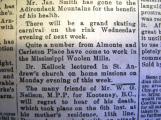 Credits:
Credits:North Lanark Regional Museum, Almonte Gazette
24
Clipping from the "Appleton News" section of the Almonte Gazette January 13, 1899:"Quite a number from Almonte and Carleton Place have come to work in the Mississippi Woolen Mills."
25
The Mississippi Woollen Mills operated for almost forty years under the Teskey family. At the turn of the century the mill began a new story, this time under the ownership of the Caldwell family of Lanark.26
Teskey Descendants at the Robert Teskey House24 July 2012
Appleton, Town of Mississippi Mills, Ontario, Canada
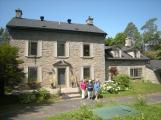 Credits:
Credits:North Lanark Regional Museum
27
Years later, the community of Appleton is still an important place to descendants of the Teskey family. Anne E. Love and Sheila Babb are both descendants of Robert Teskey and Jane Cuthbert who built the original sawmill and woollen mill in Appleton.In 2008 members from the Teskey family celebrated a Teskey Tea at the North Lanark Regional Museum, and many return each year to see the old Teskey homes, and mills in Appleton.